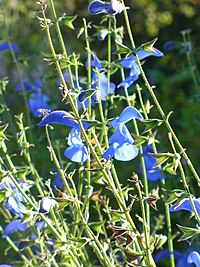| Habit | herbaceous
| |
|---|---|---|
| Height: | ⇕ | 12 in"in" can not be assigned to a declared number type with value 12. to 24 in"in" can not be assigned to a declared number type with value 24. |
| Width: | ⇔ | 12 in"in" can not be assigned to a declared number type with value 12. to 24 in"in" can not be assigned to a declared number type with value 24. |
| Lifespan: | ⌛ | perennial |
| Bloom: | ❀ | early summer, mid summer, late summer, early fall, mid fall, late fall |
| Exposure: | ☼ | part-sun |
|---|---|---|
| Features: | ✓ | flowers |
| USDA Zones: | 9 to 11 | |
| Flower features: | ❀ | blue, purple |
|
Salvia > |
patens > |
Salvia patens (sometimes called Gentian sage) is native to a wide area of central Mexico. It is a herbaceous perennial.
It was introduced to horticulture in 1838 and is now grown widely. It is frequently treated as an annual due to its sensitivity to hard frost, with bedding plants often put out in spring. Varieties have been developed with colors ranging from white to lilac to various shades of blue. Seeds from Holland have been available since the 1990s for rich colored and large flowered varieties. William Robinson praised it in the 1933 edition of The English Flower Garden as one of the best plants in cultivation. [1] A collecting trip to Mexico in 1991 led by James Compton discovered a 1.8 m (6 foot) tall variety with large deep blue flowers that is available as 'Guanajuato'.[1]
Salvia patens is tuberous, and easily lifted for overwintering in a greenhouse. The more common varieties reach 0.3 - 0.6 m (1-2 feet) tall and wide, and are covered with hastate shaped mistletoe-green leaves. Inflorescences reach 0.15 - 0.3 m (6-12 inches) or longer, rising well above the leaves. 1 inch flowers are spaced along the inflorescence, with a 1.3cm (0.5 inch) green calyx that adds to the attractiveness of the flowers.[1]
Read about Salvia patens in the Standard Cyclopedia of Horticulture
|
|---|
|
Salvia patens, Cav. Half-hardy perennial, 1-2 1/2 ft. high: sts. herbaceous, erect; pilose: lvs. petiolate, ovate-deltoid, crenate, base hastate or in the upper lvs. rotund, both surfaces hispid; floral lvs. lanceolate-linear: floral whorls few, remote, with large fls.; calyx campanulate, villous, the teeth setaceous-acuminate; corolla blue, 2 in. or more long, the tube broad. Sept. Mountains of Mex.—The most commonly cult. blue salvia. Var. alba, Hort., differs only in having white fls. Var. compacta nana, Hort., is offered in the trade. Var. lilacina, Hort., has lilac-blue fls. CH
|
Cultivation
Propagation
Pests and diseases
Varieties
Gallery
References
- ↑ 1.0 1.1 1.2 Clebsch, Betsy; Carol D. Barner (2003). The New Book of Salvias. Timber Press. p. 222. ISBN 9780881925609. http://books.google.com/books?id=NM0iwB8GrQYC&pg=PA222.
External links
- w:Salvia patens. Some of the material on this page may be from Wikipedia, under the Creative Commons license.
- Salvia patens QR Code (Size 50, 100, 200, 500)
